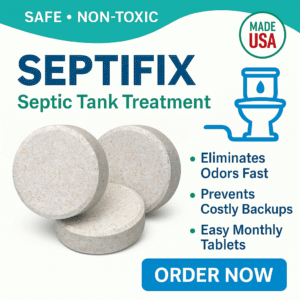Let’s face it: septic systems can feel like a mystery. You flush…and they take care of business underground. But every so often, you might wonder if giving them a boost—with bacteria packets or enzyme drops—makes sense. Does it really help? And is there a smarter, simpler way to do it?
Here’s what septic pros and researchers say about bacteria treatments, common myths, and how the easy-to-use SEPTIFIX tablet gives you fast, real results without the guesswork.
How Septic Tanks Rely on Bacteria
Your septic tank is a mini-ecosystem that relies on naturally occurring bacteria to break down waste. Solids sink to the bottom as sludge, oil and fats rise to the top as scum, and the middle layer (effluent) flows into the drain field. Bacteria do the essential anaerobic digestion that keeps everything flowing.
What Bacteria Additives Aim to Do
These products—often called “biological additives”—typically include:
- Live bacteria strains
- Enzymes like cellulase or protease
- Buffers to stabilize the tank’s pH
The idea is to enhance digestion, reduce sludge, and curb odors.
Do These Treatments Actually Work?
Unfortunately, majority of research and expert insight suggest they don’t deliver the hype:
“A well-functioning septic system already has all the bacteria it needs—from daily wastewater—so additives generally aren’t necessary.”
“Field studies found no difference in sludge levels between tanks with additives and those without.” ([turn0search18])
In many tanks, the existing bacteria populations far outweigh any introduced through a packet—the introduced amount is just too small to make an impact.
So Why Do People Still Try Them?
There’s a few legit reasons:
- Your tank may have been weakened by bleach, cleaners, or extreme use—additives might help restore balance. ([turn0search6])
- Some additives include enzymes that break down specific waste—useful in rare cases when buildup is uneven or stubborn.
But—additives won’t replace regular pumping or good septic care.
What Additives Can Backfire
Chemical-based additives are a real risk to your system:
- Harsh solvents can kill bacteria, damage concrete tanks, and clog drain fields.
- Surfactants may flush scum into the drain field, clogging soil pores and risking field failure.
Experts warn: Avoid these. They’re more likely to harm your system than help it.
Real Maintenance That Works
- Pump your tank every 3–5 years (shorter if you use a garbage disposal or have a large household).,
- Use low-impact cleaners labeled “septic-safe” to preserve your bacteria.
- Conserve water—spread out laundry and dishwashing loads instead of doing it all at once.
- Install an effluent filter—this helps protect your drain field by catching solids before they escape.
A Cleaner, Smarter Way: SEPTIFIX
Now, what if you want the convenience of additives—without the guesswork? That’s where SEPTIFIX shines.
- Just one flushable tablet each month
- Fast odor control—work begins in days, thanks to oxygen-release, not masking scents
- Breaks down grease, sludge, and toilet paper efficiently
- Supports beneficial bacteria and balances pH safely
- Toxic-free and easy—no measuring or messy powders
Try SEPTIFIX—smart maintenance made simple, safe, and powerful.
Why SEPTIFIX Works Where Additives Don’t
- It’s designed to help—not replace—your system’s natural bacteria
- It provides fast results—especially helpful when odors or slow drains crop up
- No buildup risk—just clean, repeatable support
Bottom Line
Bacteria treatments might seem helpful—but most research shows they offer little benefit in tanks that are already healthy. Additives aren’t a substitute for proper care.
If you want reliable results without the guesswork, go with something structured and effective like SEPTIFIX—your septic will thank you.
